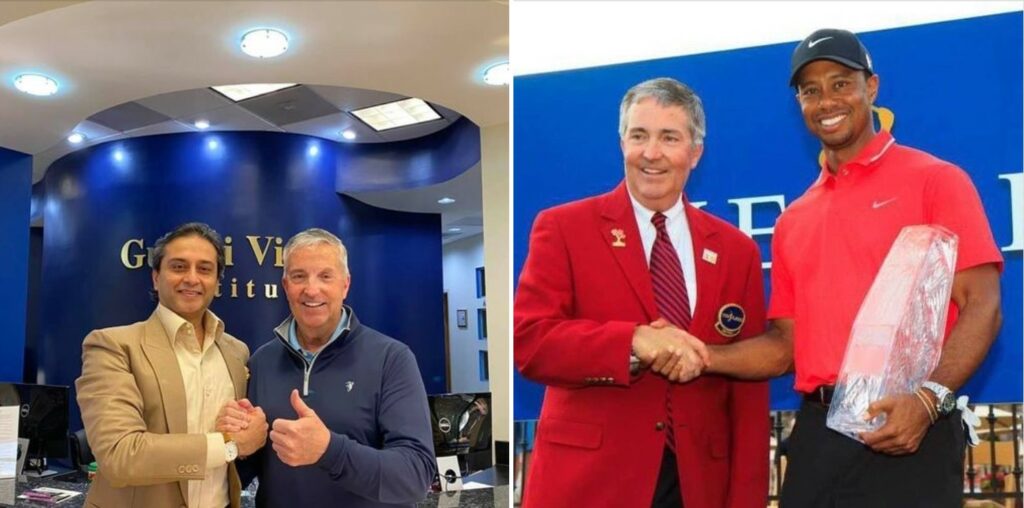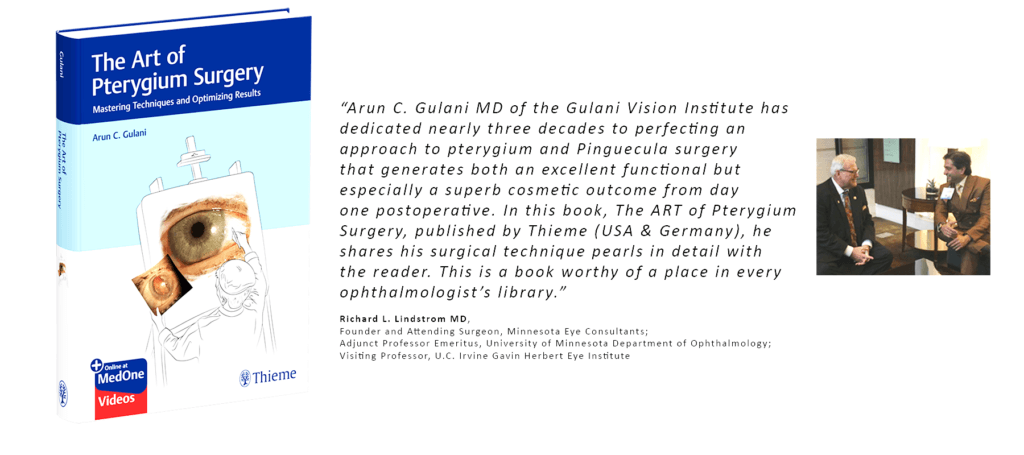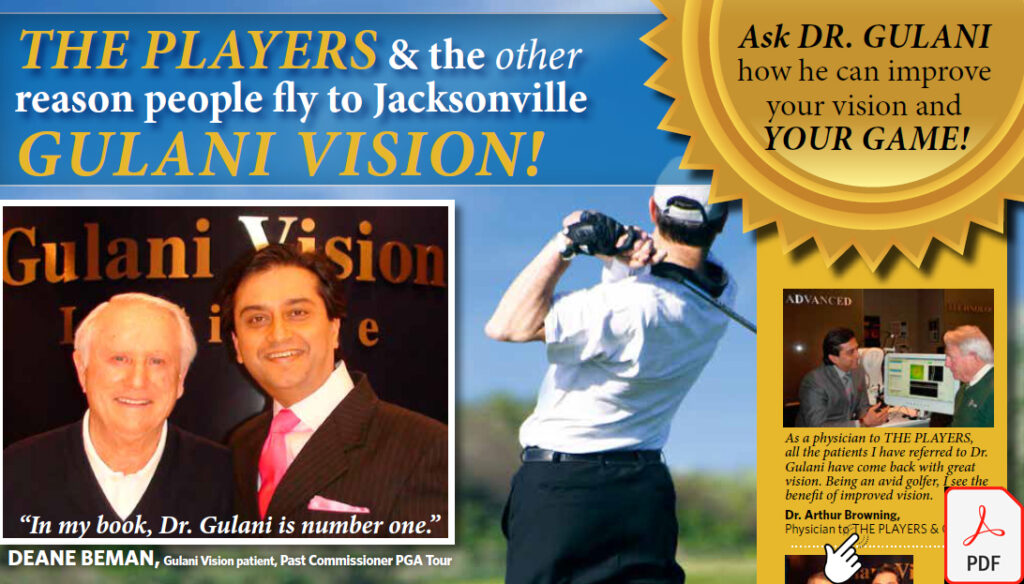The Players & the Other Reason People Fly to Jacksonville:
Jacksonville, Florida is home to The Players Championship at the beautiful Sawgrass Country Club and the internationally recognized Gulani Vision Institute, where Dr. Gulani’s world-renowned work in the field of eye care has attracted some of the world’s most famous professional golfers globally.
Golf is a sport that has always been visually demanding besides being technique and technology dependent. While, this sport enjoys all the elements of being outdoors, only to be punished by those very same forces (exposure to extreme UV lights, harsh climate, winds, allergies, and vision impact) for both players and spectators alike.
You cannot talk about golf without talking about one of our dear patients at Gulani Vision Institute, Deane R. Beman, professional golfer and past commissioner of PGA and creator of the The Players Championship. Deane Beman was referred to us for vision corrective surgery following past LASIK Surgery and underwent Dr. Gulani’s custom cataract surgery with premium lens implant. Between two perfectionists, Mr. Beman taught Dr. Gulani how to putt while Dr. Gulani explained how he should protect his eyes while golfing. Mr. Beman even said that, “In my book Dr. Gulani is number One.”

How Does Vision Impact Golf?:
Though you may debate that every sport depends on vision, it is Golf that heavily depends not only on Sight but also Vision! Sight is how small of a target you can see at a particular distance. Vision is deciphering the cues from Sight and interpreting that to our advantage for the task at hand, at that moment. The symbiosis of these two then allow a Golfer to not only see but also align their bodies, balance their stance and visualize their shot before impact itself. Herein lies the key to a successful drive or a meaningful Putt.

Dr. Gulani likes to classify the Vision demands used in Golf into the following categories:
- Quantity of Vision like 20/40, 20/20, etc.
- Quality of Vision like:
- Contrast sensitivity to decipher different levels of visual inputs in different lighting conditions
- Depth perception to best apply learned techniques in 3 dimensions
- Spatial resolution to plan and direct putting and long drives effectively
- Convergence to align the target at a particular distance
- Peripheral visual field to look at the big picture for cues or neglect
Having operated on numerous professional golfers for over three decades, Dr. Gulani can predict the visual needs of each player to maximize their hand-eye coordination in executing what their astute mind has planned in this mentally intuitive sport. So whether you are a professional athlete or an amateur golfer the improvement in your golf swing might be limited not only by your musculature but also in you vision, by helping you see your shot and pre-shot routine.
Vision Beyond 20/20:
Using breakthrough technologies Dr. Gulani has introduced Blade-less, Flap-less, No-Cut next generation LASIK techniques (i.e. LaZrplastiqueTM) that can help most golfers safely see even beyond 20/20 in most cases. Golfers who may wear contact lenses or glasses may have Nearsightedness (Myopia), Farsightedness (Hyperopia), Astigmatism (Football shaped cornea). With technology today, we can diagnose and measure to the minutest level of vision involvement and thence correct these using computer driven, micron-precision Lasers.
As golfers advance in age (beyond 40 years) need reading glasses because the natural lens inside the eye stops zooming (no more “Tele” and “Wide” zooming like a camera does) and hence they need to keep their score cards at further distance with their arms outstretched to read or record. This condition called Presbyopia can be addresses with new generation Lens and Laser techniques.

For those golfers in their early and late 60s, the vision gets cloudy and dim due to Cataracts (a cataract is a cloudy transformation of our crystal clear, natural lens). This cataract then can be removed using modern Laser techniques and be replaced by an artificial lens implant that can in most allow them to see without glasses at distance and near. Such lens implants can be monofocal, multifocal, Tricfocal, Progressive, accommodative, and Toric (for example ReStor, ReZoom, Tecnis, Symfony, Panoptix, Trifocal Toric, Dual Optics, Light Adjustable (LAL)).
Additionally, Cataract surgery can now be planned as two stages. Following cataract surgery, patients can undergo Nex-Gen Lasik surgery to correct any residual astigmatism to thus completely fix the optics of the eyes for a glasses-free vision experience for life.
Even patients who have undergone previous cataract or LASIK surgery and did not have a choice of these advanced, multifocal / progressive lens implants at that time can now avail of New Generation Lasik surgery to help them get rid of glasses altogether.

To summarize Dr. Gulani’s age based approach for golfers, amateur and professional:
- Less than 40 years of age: No-cut, No-Blade LaZrplastique for astigmatism, nearsightedness, farsightedness.
- More then 40 years of age: Correcting reading vision (presbyopia) with presbyopic lens and laser techniques.
- More than 50 years of age LenZoplastique for distance and near vision.
- For 60 years of age and above custom designed cataract surgery.
What is Red “Golfer’s Eye”?:
As spring and summer approach we are aware of the damage the sun can cause our skin. But the sun can also impact your eyes. For golfers increased sun exposure (with increased time in extreme UV lights), dust, and wind can lead to eye conditions called pterygium or pinguecula. Pterygium and pinguecula are red or yellow-red growths on the white of the eye (cornea). If left untreated these raised growths on the cornea can grow across the eye and impact vision. While prevention is the best approach, for over three decades Dr. Gulani has used his innovative “No-Stitch” state-of-the-art surgical techniques to remove the red of “Golfer’s Eyes” and leave patients with sparkling white eyes and no recurrence.

Donnie Hammond is a charter member of the Jacksonville University Sports Hall of Fame (where he played golf), professional golfer, member of the Buy.com Tour and previous a member of the PGA Tour. Over his successful golfing career Donnie’s eyes were exposed to the elements and he suffered from “Golfer’s Eyes” (Pinguecula). Donnie had his Pinguecula corrected with Dr. Gulani 16 years ago. He recently came back and visited Gulani Vision Institute and was still Sparkling White after all this time!

Dr. Gulani was among the first to use TrueVision® 3-D Surgical Technology for treating Golfer’s Eyes (pterygium) using his No-Stitch Human Placenta surgery. The NGENUITY 3D Visualization System was developed in collaboration with TrueVision® 3D Surgical, a California-based leader in digital 3D visualization and guidance for microsurgery. It consists of a 3D stereoscopic, high-definition digital video camera and workstation to provide magnified stereoscopic images of objects during micro-surgery. Additional functionality updates simplify the surgical experience allowing for customization, including the introduction of four preset imaging modes to not only perform but also teach eye surgery across geographical barriers. Eye doctors from all over the world including industry leaders watched in awe as Dr. Gulani raised the bar on eye surgery to a whole new level and published this ground breaking work in a textbook he authored for eye surgeons globally.

Dr. Zongker became the first in the world to undergo 3-D Pterygium (“Golfer’s Eye”) surgery with Dr. Gulani. He subsequently brought his wife to and has referred other golfers to Dr. Gulani including Ernie Vaderson. The late Ernie Vaderson had over 20 years of experience in designing and assembling custom golf clubs for professional and serious amateur golfers. During those years, Mr. Vadersen served as a consultant on equipment design and golf product marketing to some of golf’s largest equipment manufacturers including Spalding, MacGregor, Hogan and Yamaha and helped create the Snake Eyes line of golf clubs.
What are “Dry Eyes”?:
With golfers spending so much of their time outdoors they are exposed continuously to allergens, wind, and tear evaporation. This can cause dry eyes which causes symptoms ranging from: irritation, reflex tearing, itchiness, blurry vision, red eyes, sand-like feeling or grittiness, heavy eyes, tired eyes, burning, and in extreme cases even painful eyes. Now however m.o.i.s.t.TM therapy can help numerous golfers and spectators alike suffering from dry eye with a full range of dry eye techniques, including LipiFlow, MGP, and lacrimal plugs.
Protection and prevention is still key but Golfers are encouraged to visit with their eye doctors to evaluate for any of the above mentioned conditions as chances are, there is a successful option.

John Hayt, founder of the Hayt Golf Learning Center at the University of North Florida (UNF), the John Hayt Collegiate Invitational, Honorary Advisor to the Jacksonville Zoo, and Brumos Porsche racer is a man of many talents.
The Hayt Golf Learning Center is a state-of-the-art 38-acre golf practice facility that accommodates golfers of all levels. The four-hole practice facility comes complete with lighted chipping and putting greens, lighted driving range with grass tee and automatic Power Tee mats. The UNF Golf Complex also houses the University of North Florida’s men’s and women’s celebrated golf teams, with in-house locker rooms as well as their own private practice and training facility.
The Jacksvonille Zoo is the only walking safari in North East Florida and its goal is to inspire discovery and appreciation of the Earth’s wildlife through innovative experiences in a caring environment and world-class establishment.
As a golf benefactor and Porsche aficionado John now enjoys vision of 20/20 without glasses and called Dr. Gulani the “Porsche of Eye surgery.”
Handicaps in Golf may be seasonal, vision should not be. To have excellent Vision & Sight overcomes many handicaps to level the Par on the Greens.


